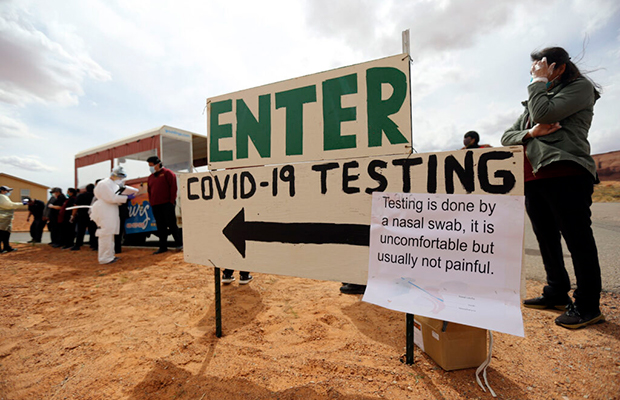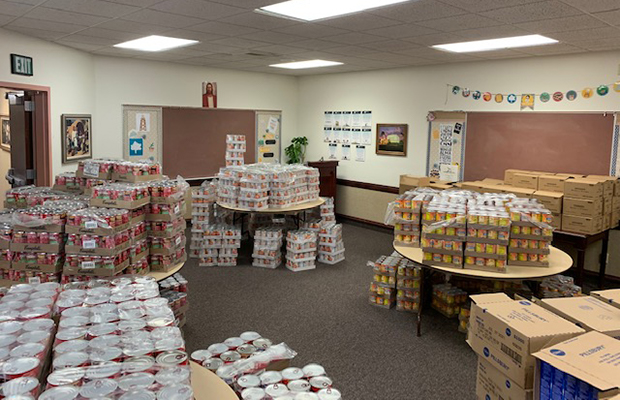Latter-day Saints Serve the Navajo Nation in the Thick of the COVID-19 Fight
Contributed By Jason Swensen, Church News reporter

Missionaries from the New Mexico Farmington Mission work alongside local members in an ongoing food distribution effort across the Navajo Nation. Photo courtesy of Bishop Ethmundo Rosales.
Article Highlights
- Missionaries and members are joining together to help the Navajo Nation survive the pandemic.
"Revelation is helping us pull through this tough time.” —Romero Brown, Chinle Arizona Stake president
Related Links
The Navajo Nation’s reputation as a global tourist hotspot is well deserved.
Stunning, cinematic locales such as Monument Valley and Antelope Canyon—coupled with the region’s rich indigenous culture—have long drawn waves of filmmakers, adventurers, and academics.
But in recent weeks, the Navajo Nation has become, sadly, another type of hotspot. The Indian territory stretching across a vast section of the American Southwest recently surpassed New York and New Jersey for the highest per-capita coronavirus infection rate in the United States according to CNN.
As of May 18, the Navajo Nation had approximately 2,300 cases of COVID-19 per 100,000 people. By contrast, New York state had an approximate rate of 1,800 cases per 100,000.
Counted among the virus victims are members of The Church of Jesus Christ of Latter-day Saints.
“It has been a challenge—this thing is real,” said Tuba City Arizona Stake President Ollie Whaley.
Sixteen members of President Whaley’s stake have been diagnosed with COVID-19. And the virus claimed the life of one stake member, a 31-year-old man. “We had a graveside service for that man a week ago,” he said. “It was a very sad thing.”
While some from the Tuba City stake have recovered, others continue their battle with the disease “and are in the long process on the road to recovery,” said President Whaley.
Meanwhile, several members from the Chinle Arizona Stake have tested positive for COVID-19. There have been no virus-related deaths in the Chinle stake, as of press time.

People line up for COVID-19 testing outside the Monument Valley Health Center in Oljato-Monument Valley, San Juan County, on Thursday, April 16, 2020. The coronavirus hotspot is part of the Arizona Tuba City Stake. Photo by Kristin Murphy, Deseret News.
The infection rate “has stayed down in our stake, and I’m very thankful for that,” said President Romero Brown of the Chinle stake.
Virus Exacting Steep Economic Toll
Like many other coronavirus hotspots around the globe, the disease is exacting a steep economic toll on members of the Navajo Nation and other neighboring Indian tribes—including many Latter-day Saints.
Within the Tuba City stake boundaries are the entire Hopi Nation and the western half of the Navajo Nation. The stake stretches from the Grand Canyon to Monument Valley, two popular tourist destinations integral to the region’s economy.
“Many of our members are heavily involved with tourism, doing things like operating tours and selling arts and crafts. Those things have been completely shut down as a result of this pandemic,” said President Whaley.
Ministering to and caring for individuals living in wards and branches in the Navajo Nation are logistical challenges under normal circumstances. Vast distances separate communities, farms and ranches. And rural residents do the best they can to stay connected with their neighbors despite limited WiFi access and other forms of communication.
“We don’t have the kind of infrastructure that you find in other places,” said President Whaley. “Not everyone has access to the Internet or even phone signals.”

Vehicles line up for COVID-19 testing outside of the Monument Valley Health Center in Oljato-Monument Valley, San Juan County, on Friday, April 17, 2020. More than a thousand people got tested over the course of two days. As of May 19, 2020, the Navajo Nation has the highest per capita COVID-19 infection rates in the country. The Monument Valley region is part of the Arizona Tuba City Stake. Photo by Kristin Murphy, Deseret News.
Such deficiencies have been magnified with Church meetings and other ecclesiastical interactions happening almost entirely, in recent months, via Zoom conferences, emails, and texts.
Other emerging realities of the pandemic are also undermining traditional ministering.
Civic leaders have implemented curfews and weekend lockdowns across areas of the the Navajo Nation and beyond over the past several weeks to help flatten curves and stem the spread of the virus.
“We would be breaking the law of the land if we try to get out and, say, deliver the sacrament on Sunday,” said President Whaley.
In the early days of the pandemic, local priesthood holders on the Navajo Nation were often dispatched to homes on Sundays to assist with the sacrament. That’s no longer an option in some areas.
Worthy priesthood holders have been authorized to administer the sacrament in their own residences. “And for homes without the priesthood, we are asking our members to exercise their faith and look forward to the day when they can again partake of the sacrament,” said President Whaley.
In the Chinle stake, meanwhile, “people have been fasting and praying for one another and providing Church humanitarian help wherever we can,” said President Brown.
Inspired Coordination between Relief Society, Priesthood
As expected, bishops, branch presidents, and local Relief Societies are proving essential in caring for Latter-day Saints across the Navajo Nation and neighboring communities—and seeking the Lord’s direction in doing so.
“President [Russell M.] Nelson and our other leaders have counseled us to ‘Hear Him,’” said President Whaley. “That’s very real here. We have to trust our bishops and elders quorum presidents and Relief Society presidents to find their own answers and hear His voice for themselves to meet the needs of our people.”
Ward and branch Relief Society and priesthood leaders across the Navajo Nation are working with tribal leadership, area hospitals, and the full-time missionaries to carry out humanitarian projects across the reservation.
Tuba City Arizona Stake Relief Society President Eleanor Williams said coordination—both inside and outside the Church—remains vital in ministering to members and their neighbors.
“We are so grateful for the gospel—and we’re listening to the promptings of the Spirit to meet the needs of our families,” she said.

Korene Atene, a certified nursing assistant with the Monument Valley Health Center, gets information from people lined up to get tested for COVID-19 outside of the center in Oljato-Monument Valley, San Juan County, on Thursday, April 16, 2020. The Navajo Nation has the highest per capita COVID-19 infection rates in the country. The Monument Valley region is part of the Arizona Tuba City Stake. Photo by Kristin Murphy, Deseret News.
The Tuba City stake center is being used as a sewing center for fabricating masks and hospital gowns. Such protective products, said President Whaley, are “not only serving our local hospital, but in hospitals throughout the reservation.”
Food donations from the Church and other private industries, including a member-owned potato company from Idaho, are helping to feed members hit hard economically.
“We have been so grateful for those contributions,” said President Brown.
The Tuba City stake, for example, coordinates food distribution points in areas across the reservation.
“We are delivering food, prescriptively, under the direction of the local bishops and Relief Societies, with the help of the missionaries from the New Mexico Farmington Mission,” said President Whaley.
Meanwhile, Relief Society sisters from the Tuba City stake made aprons as a special Mother’s Day gift for many women practicing social isolation in their homes.
Similar efforts are operating in the Chinle stake, where volunteers are delivering food packages to socially isolated members living in remote areas.
Of key concern for priesthood and Relief Society leaders on the Navajo Nation are older folks who are especially vulnerable to infection and need to stay home. A key ministering element is educating members on properly protecting themselves.
Native culture is communal, explained President Whaley. People typically live in family groups. “And at times like this, it’s hard because they need to keep a certain distance and be careful in how they interact, even with people that they love.”

Donated food items to be distributed to people in need across the Navajo Nation are stored at the Arizona Tuba City Stake Center. Photo courtesy of Bishop Ethmundo Rosales.
The ongoing pandemic remains a threat to the physical health of Latter-day Saints living in the Navajo Nation. But local leaders also recognize one’s spiritual health is vulnerable. It too needs care and attention.
“We are reminding people of the direction that the prophet has given us to use the Come, Follow Me program. That revelation is helping us pull through this tough time,” said President Brown.
The Chinle stake president fought emotion as he considered the many who are reaching out and asking for spiritual comfort in a time of fear.
“Many of our people,” he said, “are evaluating their lives and renewing their commitment to the gospel.”
